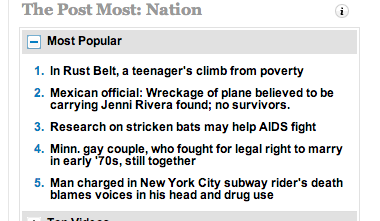Now that the confetti and campaign corks had been swept up after news leaked that The Washington Post was probably going to, finally, charge for its digital content, the question arises: Will people pay, and for what?
Worries about a shrunken newsroom are legitimate. This, after all, is the main value-creator.
Yesterday’s page-one profile of Tabitha Rouzzo, a lower-middle-class (that is, very poor) high school student with dreams of getting out of a depressed New Castle, PA, presents the question another way.
The story is just plain old public-interest reporting. It does, in my view, one of the more valuable things that journalism can do: connect elite readers with places and people they wouldn’t otherwise know about. “Public interest” usually means something that doesn’t benefit anyone much in particular, but everyone some in general. It is original. In other words, it’s not pegged to some news issued by an institution. You can read it as a profile, or, as clearly intended by the Post, as a description of, and metaphor for, broad swatches of the US economy, where schools are declining, manufacturing is gone, and all the jobs are low-wage. Deer skinning, we learn, is a job.
Seriously, the personal and social toll of a low-wage economy are all visible in the microcosm described here. The value, in Herbert Gans’s phrase from long ago, is in allowing a different set of representations into the “symbolic arena.”
But let’s face it, the downer subject, and the five screens of copy, all but cry, “skip me.” It had other obstacles to popularity. It’s written in newspaper-feature-ese, so some of the writing might seem strained, depending on your taste. I couldn’t find it on my mobile phone, either on the Post’s mobile app or via my browser. The piece is economics-statistics-free—a smart editorial decision, but it doesn’t leave much room for interactivity. This is just a story.
Plus, it didn’t come cheap and required reporting over several months. Unfortunately, that’s how long it takes to accumulate just the right amount of telling detail and just the right quotes. Here’s a snippet, for instance, that speaks volumes about the economic chasm between Tabi and a middle-class friend after a trip to visit a nice campus with him and his parents. Forget tuition, she was blown away by the bill at lunch, and we’re not talking about the Four Seasons.
On the way back to New Castle, they stopped for dinner at Olive Garden. Tabi couldn’t help noticing the bill. “It was like $70!” Tabi said. “And it was no sweat off their back.”
And this quote says quite a bit about the differing worldviews of the grimly determined daughter and her single, public-assistance-dependent mom.
Her mother had five kids and no husband at age 23. Tabi, the last born, was a welfare and WIC baby who grew up with evictions and lights getting cut off. Her 39-year-old mother remembers it differently.
“I tried to give them everything,” Patricia said. “You wouldn’t find one of my kids without a matching bed set.”
Pretty good.
And I’ll just add this bit because I found it moving: a description of the crowd of teenagers at one of the bright spots in their lives, a Wednesday night heavy-metal concert and motivational sermon held at a local church.
“There’s more to life than nothing,” Seth [a motivational speaker] said, as the electric keyboard softly lulled and the lights dimmed. “There’s more to life than this town.”
Words to Tabi’s ears. She was not exceptionally pious and she had made her share of transgressions, but she always felt better at this moment when she closed her eyes and let go. The kids from the bus had their heads bowed, too. Some were wiping away tears, a few were sobbing, their shoulders heaving in the darkness of the church.
This is one of those pieces that benefits from being produced by a large news organization, MSM, if you will. It takes time and money and has impact precisely because the institution already has a mass audience.
And you know what? It beat anything in the Times yesterday.
But will people pay for it? I don’t know. But here’s one hint, as of about 8:30 this morning:

If you did a time-motion study, I doubt that story pays for itself, strictly speaking. But in a broader sense, I bet it does.
Dean Starkman Dean Starkman runs The Audit, CJR’s business section, and is the author of The Watchdog That Didn’t Bark: The Financial Crisis and the Disappearance of Investigative Journalism (Columbia University Press, January 2014). Follow Dean on Twitter: @deanstarkman.
